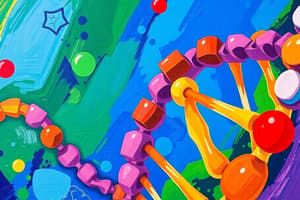Podcast
Questions and Answers
What is the primary function of DNA in living organisms?
What is the primary function of DNA in living organisms?
- To produce energy for cellular functions
- To facilitate cellular communication
- To hold the instructions for development, survival, and reproduction (correct)
- To serve as a structural component of cells
Which of the following correctly describes the monomers that make up DNA?
Which of the following correctly describes the monomers that make up DNA?
- Nucleotides (correct)
- Amino acids
- Fatty acids
- Carbohydrates
Which of these components is NOT part of a nucleotide?
Which of these components is NOT part of a nucleotide?
- Phosphate group
- Base
- Sugar
- Amino group (correct)
How does Chargaff's Rule describe the relationship between purines and pyrimidines in DNA?
How does Chargaff's Rule describe the relationship between purines and pyrimidines in DNA?
What are the two types of nitrogenous bases found in DNA?
What are the two types of nitrogenous bases found in DNA?
Which sugar is found in the nucleotides of DNA?
Which sugar is found in the nucleotides of DNA?
What structural feature of DNA allows it to store information over the long term?
What structural feature of DNA allows it to store information over the long term?
What role do genes play in a cell?
What role do genes play in a cell?
What is the term used for the bonding that holds the two strands of DNA together?
What is the term used for the bonding that holds the two strands of DNA together?
What pairs with adenine in DNA structure?
What pairs with adenine in DNA structure?
Which nucleotide is not included in the DNA structure?
Which nucleotide is not included in the DNA structure?
Which feature describes the orientation of the two strands in a DNA double helix?
Which feature describes the orientation of the two strands in a DNA double helix?
In which form of DNA is hydration essential for its stability?
In which form of DNA is hydration essential for its stability?
Which base-pair combination follows Chargaff's Rule?
Which base-pair combination follows Chargaff's Rule?
What does GC content refer to in DNA?
What does GC content refer to in DNA?
Which statement about the DNA double helix is incorrect?
Which statement about the DNA double helix is incorrect?
Which two organisms have the highest and lowest GC content for their DNA?
Which two organisms have the highest and lowest GC content for their DNA?
Which of the following is true about Z-DNA?
Which of the following is true about Z-DNA?
What describes a gene in the context of molecular biology?
What describes a gene in the context of molecular biology?
Which of the following is NOT typically a component of a gene's structure?
Which of the following is NOT typically a component of a gene's structure?
What is the approximate average length of human genes in terms of introns and exons?
What is the approximate average length of human genes in terms of introns and exons?
Which term refers to the segments of a gene that contain the information needed to make a protein?
Which term refers to the segments of a gene that contain the information needed to make a protein?
What is the function of introns in genes?
What is the function of introns in genes?
What is the longest recorded length of a human gene?
What is the longest recorded length of a human gene?
How do gene families arise?
How do gene families arise?
What unit is commonly used to describe the length of DNA molecules?
What unit is commonly used to describe the length of DNA molecules?
What are the functional end products of gene expression?
What are the functional end products of gene expression?
Which statement best describes a pseudogene?
Which statement best describes a pseudogene?
The molecular clock is used to measure what aspect of genes?
The molecular clock is used to measure what aspect of genes?
What is a common characteristic of complex multigene families?
What is a common characteristic of complex multigene families?
Which genes are involved in binding and transporting oxygen in humans?
Which genes are involved in binding and transporting oxygen in humans?
What is the role of noncoding RNAs in a cell?
What is the role of noncoding RNAs in a cell?
The alpha-globin genes are located on which chromosome in humans?
The alpha-globin genes are located on which chromosome in humans?
What is the expected outcome as time passes since gene duplication?
What is the expected outcome as time passes since gene duplication?
What happens to genes that are duplicated and subsequently lose their function?
What happens to genes that are duplicated and subsequently lose their function?
Flashcards
What is DNA?
What is DNA?
DNA is a linear polymer composed of repeating nucleotide monomers.
What are nucleotides?
What are nucleotides?
A nucleotide consists of three components: a deoxyribose sugar, a phosphate group, and a nitrogenous base.
What are the four bases in DNA?
What are the four bases in DNA?
Adenine and guanine are purines, while cytosine and thymine are pyrimidines. The bases are attached to the deoxyribose sugar via a β-N-glycosidic bond.
What is Chargaff's Rule?
What is Chargaff's Rule?
Signup and view all the flashcards
What are genes?
What are genes?
Signup and view all the flashcards
Why is DNA important?
Why is DNA important?
Signup and view all the flashcards
What is DNA's role in inheritance?
What is DNA's role in inheritance?
Signup and view all the flashcards
Why is DNA stable?
Why is DNA stable?
Signup and view all the flashcards
What are the four nucleotide bases in DNA?
What are the four nucleotide bases in DNA?
Signup and view all the flashcards
How are nucleotides linked in DNA?
How are nucleotides linked in DNA?
Signup and view all the flashcards
What are the two ends of a DNA strand?
What are the two ends of a DNA strand?
Signup and view all the flashcards
What structure does DNA have?
What structure does DNA have?
Signup and view all the flashcards
What are the major and minor grooves in DNA?
What are the major and minor grooves in DNA?
Signup and view all the flashcards
What holds the two strands of DNA together?
What holds the two strands of DNA together?
Signup and view all the flashcards
What is GC content?
What is GC content?
Signup and view all the flashcards
What is the most common form of DNA?
What is the most common form of DNA?
Signup and view all the flashcards
Gene Expression
Gene Expression
Signup and view all the flashcards
Gene Family
Gene Family
Signup and view all the flashcards
Complex Multigene Family
Complex Multigene Family
Signup and view all the flashcards
Gene Duplication
Gene Duplication
Signup and view all the flashcards
Molecular Clock
Molecular Clock
Signup and view all the flashcards
Pseudogene
Pseudogene
Signup and view all the flashcards
Translation
Translation
Signup and view all the flashcards
Proteins
Proteins
Signup and view all the flashcards
Codon
Codon
Signup and view all the flashcards
Human Genome
Human Genome
Signup and view all the flashcards
What is a base pair (bp)?
What is a base pair (bp)?
Signup and view all the flashcards
What is a gene?
What is a gene?
Signup and view all the flashcards
Explain the difference between exons and introns.
Explain the difference between exons and introns.
Signup and view all the flashcards
What is a gene family?
What is a gene family?
Signup and view all the flashcards
How do gene families arise?
How do gene families arise?
Signup and view all the flashcards
Why are genes important for cell function?
Why are genes important for cell function?
Signup and view all the flashcards
Why are gene families important for evolution?
Why are gene families important for evolution?
Signup and view all the flashcards
Do longer genes contain more information?
Do longer genes contain more information?
Signup and view all the flashcards
Study Notes
DNA Structure
- DNA is a polymer, composed of monomers called nucleotides.
- Each nucleotide consists of three parts: a sugar (2'-deoxyribose), phosphate groups, and a base.
- The sugar is 2' deoxyribose.
- Four bases exist in DNA: adenine (A), guanine (G), cytosine (C), and thymine (T).
- A and G are purines; C and T are pyrimidines.
- Bases are attached to the sugar via a β-N-glycosidic bond.
- Chargaff's rule states the total number of purines equals the total number of pyrimidines in a DNA molecule.
- The names of the four nucleotides are: 2'-deoxyadenosine 5'-triphosphate (dATP), 2'-deoxyguanosine 5'-triphosphate (dGTP), 2'-deoxycytidine 5'-triphosphate (dCTP), and 2'-deoxythymidine 5'-triphosphate (dTTP).
- Nucleotides are joined together via phosphodiester bonds.
- DNA has a 5' to 3' direction.
- DNA in living cells is a double helix composed of two polynucleotide strands.
- The double helix structure was discovered by James Watson and Francis Crick in 1953, based on data from Rosalind Franklin and others.
DNA Double Helix
- DNA has an antiparallel structure, meaning the strands run in opposite directions.
- It possesses a major and minor groove.
- The two strands are held together by complementary base pairing (A with T, G with C), via hydrogen bonds.
- DNA can exist in different forms: A-DNA, B-DNA, and Z-DNA.
Important Features of DNA Types
- B-DNA is the most common and predominant form.
- A-DNA is rare, found during dehydrating conditions.
- Z-DNA is found naturally with B-DNA in specific regions, its biological activity isn't fully understood.
Additional Features
- The amount of G+C nucleotides in an organism's DNA is referred to as GC content. Human DNA has a GC content of 40.3%. Examples of other organisms GC content are provided, such as Plasmodium falciparum (19.0%) and Streptomyces griseolus (72.4%).
Resources for Further Study
-
Introduction to Genetics, a Molecular Approach by Brown.
- Chapter 2, pages 11 to 19.
-
Essential Cell Biology by Alberts.
- Chapter 5, pages 173 to 178.
-
Supplementary material is available on Blackboard. This includes PDFs containing reading materials, learning objectives, keywords, and exercises.
Studying That Suits You
Use AI to generate personalized quizzes and flashcards to suit your learning preferences.




